SAN DIEGO (News Analysis) -- Two leading
proponents of atomic energy, who clashed over the extent of the Fukushima
exclusion zone two years ago, now stand united in their opposition to
nuclear power. Inside the chambers of the San Diego County Board of Supervisors
on June 4, a rapt audience listened to insider disclosures from Naoto
Kan, prime minister during the March 2011 triple disaster, and Gregory
Jaczko, then-chairman of the U.S. Nuclear Regulatory Commission (NRC).
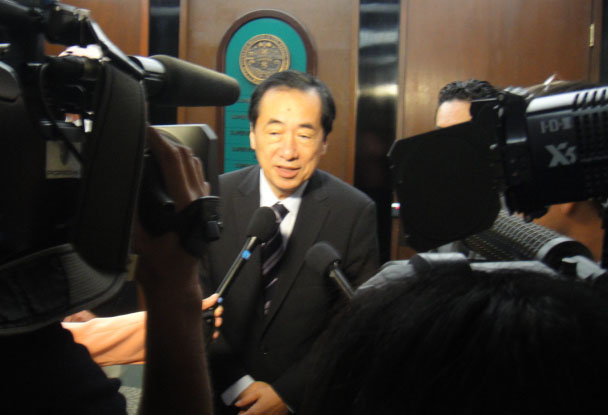
Naoto Kan, who was prime minister
during the March 2011
triple crisis in Fukushima, meets the press in San Diego on June 4.
The forum was summoned by San Diego supervisors to learn the lessons from
Fukushima applicable to the present debate over the proposed restart of
Southern California Edison’s nuclear station at nearby San Onofre. Other
panelists included: San Diego County supervisor David Roberts; Peter Bradford,
former NRC member and professor at Vermont Law School; and retired nuclear
executive Arnold “Arnie” Gundersen, chief engineer at Fairewinds Associates.
San Diego was an important venue for the forum for two reasons.
- The populous county
is the site of leak-plagued SCE San Onofre, where damaged steam-generator
tubes could trigger a nuclear crisis in the United States equivalent to
the Fukushima disaster.
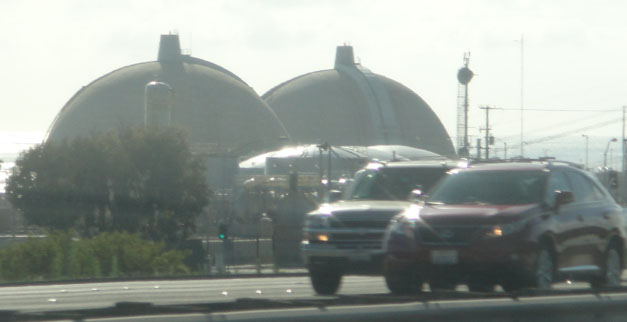
Twin domes of the Southern California
Edison reactors at San Onofre
- The city is home
port for the supercarrier USS Ronald Reagan, which was seriously contaminated
in Japanese waters during the March 2011 meltdowns. Navy personnel aboard
the radiation-hit vessel have since filed a lawsuit for health-related
damages with the U.S. district court in San Diego, charging that the Tokyo
Electric Power Company (TEPCO), which is now largely owned by the Government
of Japan, failed to provide accurate and timely warning of harmful levels
of radiation released during the initial phase of the meltdowns.
Reversal of Opinion
Fukushima’s incalculable damage to Japan’s once-mighty economy convinced
Kan and Jaczko to reverse their long-standing support for nuclear power
as a clean and safe energy resource.
“Before March 11, my thoughts about nuclear power were focused on how
it could benefit Japan’s economy, without giving much concern for safety,”
said the former prime minister. “Since 3.11 my whole thinking turned around
180 degrees . . . because of the great risk of mass destruction.”
“Fukushima was a wake-up call of how a postulated situation of low probability
could actually happen,” Jaczko concurred. “Accidents happen.”
A potential meltdown at San Onofre could be far costlier than the Fukushima
situation, said Supervisor Roberts, because the population within 50 kilometers
of the troubled facility is about 8 million residents, or roughly four
times larger than that of Fukushima Prefecture. At the periphery of the
southlands, Los Angeles is dozens of kilometers closer to SCE San Onofre
than Tokyo was to the damaged TEPCO plant, pointed out Kendra Ulrich,
a nuclear-issues consultant for Friends of the Earth.
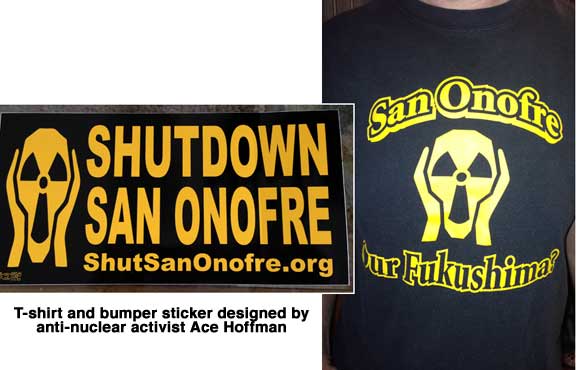
Jaczko disclosed that in the wake of the 3.11 disaster the NRC estimated
the initial economic toll from the Fukushima disaster would reach 500
billion dollars, not including future costs of decommissioning, storage
of nuclear waste and medical care for long-term health effects. Kan added
that politicians who still believe in the myth of nuclear safety are not
taking into account the high cost for future generations of Japanese of
storing plutonium and other nuclear byproducts over the next 100,000 years.
Bilateral Controversy on the Exclusion Zone
The about-face on the risks of nuclear power does not, of course, resolve
the continuing conflict between the governments of Japan and the U.S.
over the risk to human health in the early weeks of the Fukushima meltdowns.
That controversy remains at the nub of the legal complaint in San Diego
federal court and for lawsuits filed in Japan.
Soon after the Fukushima meltdowns were detected, the prime minister’s
office ordered a no-entry boundary and evacuation zone set at 20-kilometers
(12 miles) radius around the wrecked Fukushima No.1 nuclear plant. Meanwhile,
the 5- member board of the NRC, under chairman Jaczko’s watch, issued
a travel advisory to American citizens from entering into a 50-km-deep
(30 miles) radius of the damage nuclear plant. This amounted to a land
area more than six times larger than the Japanese government’s hot zone.
Jaczko said that the higher NRC risk estimate was determined from available
data at the time. Naota Kan stated at the forum that his decisions were
based on information as it arrived from government bureaus on a daily
basis. He now admits that data may have been skewed due to a conflict
of interest within the watchdog Nuclear and Industrial Safety Agency (NISA),
a non-independent arm of the Economy Ministry, which acted as both promoter
and regulator of the nuclear industry. Whether these circumstances absolve
the prime minister’s office of liability remains to be determined in the
courts of law.
Kan’s first-person recollection of the scale of the disaster, however,
weighs against that decision to designate a relatively small evacuation
zone for Fukushima residents. Immediately after the earthquake, he recalled,
TEPCO issued a notice that all systems at Fukushima No.1 facility were
intact and operational. “Four hours later, however, Reactor 1 began to
melt down.” Kan said, “and in stark contrast to the emergency cooling
operation at Three Mile Island, the plant operator was unable to do the
same at Fukushima No.1.”
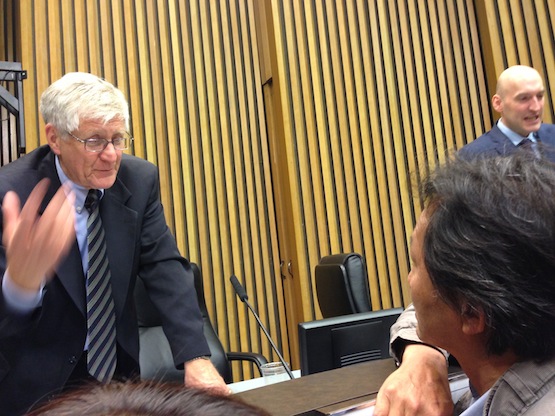
Nuclear industry critic Arnie Gundersen,
head of Fairewinds Associates,
chats with the author inside the chambers of the San Diego County Board
of
Supervisors. Retired NRC chair Gregory Jaczko stands in the background.
Without mention of the specific notification date, Kan added: “The corium
of Reactors 1 and 2 was slowly melting through the 20-centimeter-thick
containment vessel and then the 2-meter concrete barrier was ruptured.
(It should be noted here that TEPCO and the Japanese government did not
admit to breeches of the reactor shells until many months after March
11).
Kan confirmed that the upper management of TEPCO openly defied the prime
minister’s office while the meltdowns intensified. “On March 15, following
the explosion of Reactor 3, TEPCO wanted to evacuate all personnel from
Fukushima No.1,” he explained. “If I had accepted that request, the situation
would have spiraled out of control at the six reactors and seven spent-fuel
pools at Fukushima No.1 and an additional four reactors at Fukushima No.2
plant just 12 km away.”
A chilling what-if scenario followed. “If all 10 reactors and 11 SFPs
at Fukushima had exploded, the fallout would have been 10-to-20 times
greater than Chernobyl. If that had happened, the evacuation of the Greater
Tokyo region, some 50 million residents spread over a 140-km area, would
have become necessary. It is a practically impossible challenge when considering
the difficulty of transporting the elderly from senior centers and children
from schools. The adversity of losing one-third of the nation’s land mass
and relocating 40 percent of its population would have been worse than
a war.”
Arnie Gunderson added that more than 1,000 nuclear-plant employees were
present on the afternoon of March 11 and all of those dedicated workers
decided to stay on the job to avert a cataclysm. “If the earthquake and
tsunami had struck at nighttime, only 100 workers would have been inside
the plant, and the rest could not have entered the site due to the power
blackouts and damage to the surrounding infrastructure.” A margin of less
than three hours prevented the unimaginable.
Truth as First Casualty
When asked about his awareness of the radiation monitoring and fallout
simulation program known as SPEEDI, Kan’s vague response was that his
office acted with as much transparency as possible whenever information
became available from the various ministries. In fact, it was not the
government but an editor with The Japan Times who exposed the existence
of the SPEEDI radiation monitoring program, which indicated dispersal
of massive exposure levels across Japan and around the Northern Hemisphere.
The official response to disclosure of the secret radiation-monitoring
program was threats against the editor and his subsequent demotion. Likewise,
journalists and editors who tried to counter the news blackout and official
cover-up with investigative reporting were accused of alarmism by pro-nuclear
bureaucrats and utility firms that place lucrative ads in newspapers and
television.
Meanwhile, the TEPCO public-relations machine run by Hakuhodo and other
ad agencies and a corporate-friendly mass media assured residents that
the Fukushima situation was under control and safe for children, even
as highly radioactive iodine and xenon gas was swirling into the United
States, Canada and Greenland along with the Russian Far East, Mongolia
and northeast China. More recently, major celebrities and minor talents
from Western countries have been recruited by the Information Ministry
to pay visits to tsunami-struck areas in a well-publicized media blitz
that avoided mention of radiation exposure suffered by Fukushima residents.
Money buys media lies.
The medical effects of radiation exposure are less known to the public,
even to most of the nuclear experts at the San Diego forum, due to the
complexity of interpreting the limited health data available in Japan.
This pressing issue was raised by a Japanese expatriate with two sons,
Miki Tamura Bay, who implored Kan: “What will the government do about
all the children in Fukushima?” His answers were to fight for healthcare
for the affected groups and, in the long run, to abolish nuclear power.
Out of the Loop
Kan’s reluctance to discuss the news blackout and pervasive disinformation
campaign related to Fukushima is rooted in the very structure of Japanese
political system. Even though he was the leading figure in the then ruling
Democrat Party, the fact remains that any Japanese prime minister is a
mere sock puppet for the secretive bureaucrat-run system. Kan was less
compliant than most, and thus relegated as a political outsider.
Since his career-start as a grassroots activist among low-income communities,
the elitist establishment has disparaged Kan as a maverick with an upstart’s
short fuse for bureaucratic foot-dragging. Throughout his political career,
the conservative press has routinely libeled him with ludicrous accusations,
ranging from patently false charges of adultery to being of non-Japanese
racial descent.
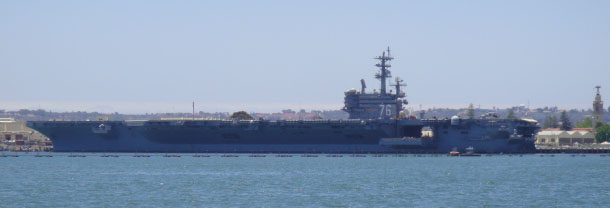
The USS Ronald Reagan, after months
of refitting at the Puget
Sound Naval Shipyard in Bremerton, Washington, is docked in San Diego
harbor without its former array of attack jets and helicopters
To veteran journalists and media commentators in Tokyo, it was obvious
from the start of the Fukushima crisis that Prime Minister Kan was being
deliberately excluded from the information loop by the Ministry for Industry
and Economy, which oversees the nuclear industry. After TEPCO defied his
order to pump seawater into the overheated reactors, corporate chairman
Masataka Shimizu refused to meet Kan in person and remained absent from
duty on grounds of “hospitalization”. The ploy severed the utility company’s
communication with the prime minister’s office, thereby sabotaging Kan’s
plan to create a joint corporate-government headquarters to coordinate
the emergency response to the burgeoning meltdown crisis.
After Kan ordered an indefinite shutdown of all 54 reactors across Japan
and a halt to future nuclear licensing, the boom was dropped on his premiership.
Within six months of the 3.11 crisis, Kan was ousted by an inner-party
coup engineered by pro-nuclear Democrats allied with conservative Liberal
Democrats. That is the reward for ethical integrity. At the San Diego
forum, Arnie Gundersen tipped his hardhat in praise of Kan for “having
the courage to stand down TEPCO.”
As fears of Fukushima fallout spread across the Pacific to the American
public, the pro-nuclear camp within the NRC circled its wagons and forced
Jaczko’s resignation as chairman after his refusal to approve licensing
for a new nuclear plant in Georgia. In spite of these collusive actions
by an entrenched bureaucracy, the rising costs of nuclear power production
is dooming what former NRC member Peter Bradford calls “the nuclear renaissance.”
Of the 39 applications for new plants on file or in the works in 2009,
only four have been approved so far. Nuclear energy is noncompetitive
with the lower production cost of natural gas, even when the risks of
a Fukushima-type disaster are not taken into account.
Honest Voices, Hard Choices
Professional etiquette limits insiders from disclosing the whole ugly
situation, and that unspoken rule held fast at the San Diego forum. Kan
the politician stopped short of condemning Japan’s sclerotic system of
corrupt governance and Jaczko the administrator refrained from lambasting
the chicanery from SCE San Onofre. The pros always leave themselves some
wiggle room.
Despite these shortfalls, which pale against the nuclear industry’s ruthlessness,
Naoto Kan and Gregory Jaczko are basically honest voices who were removed
from their leadership posts by corrupted bureaucrats beholden to the nuclear
lobby. To his credit, Kan went further on record in San Diego by condemning
the Japanese nuclear industry’s campaign to export nuclear technology
to Turkey, Vietnam and India.
However his comments might influence litigation in the months ahead, Naoto
Kan gave a huge boost to the anti-nuclear movement by coming to San Diego
to support the worldwide network against nuclear power and in favor of
renewable energy. His visit came just in time. The near-dormant antinuclear
movement in Japan recently reawakened when a massive crowd of up to 60,000
protesters surrounded the official residence of pro-nuclear Prime Minister
Shinzo Abe.
The question ahead is whether the Democrat faction led by Kan can forge
an electoral coalition with his former opponents in the anti-nuclear Mirai
(Future) Party and Shin-Kokuminto (New Populist Party) to inflict a resounding
electoral defeat on the ruling Liberal Democrats in the Upper House elections
set for mid-July. When the options are to roll over and die or to fight,
the choice is clear.
END
Yoichi Shimatsu, a Hong Kong-based science journalist, has served
as an editor with the Japan Times group in Tokyo and is an environmental-health
consultant to Fukushima residents.
|
![]()